
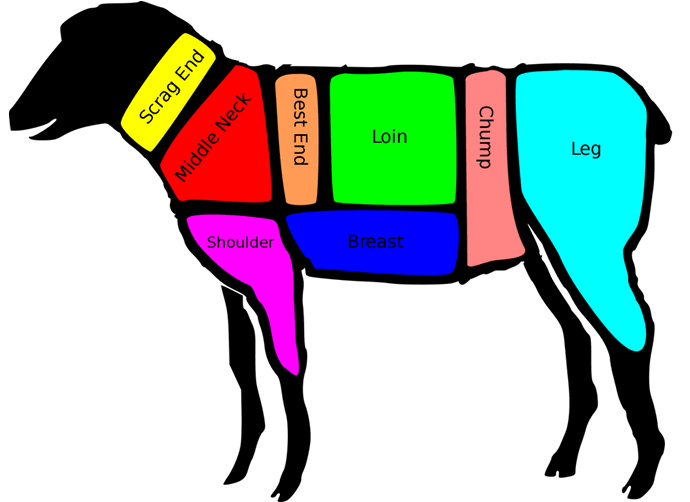
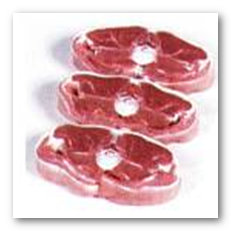
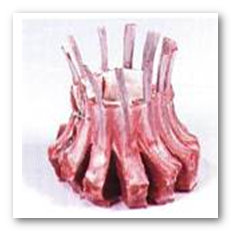

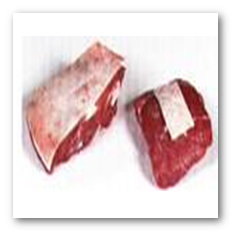
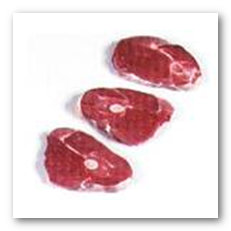
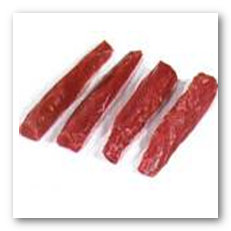
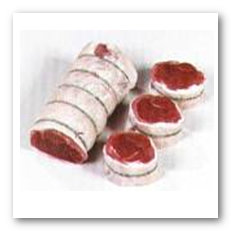

Lamb
The meat of a lamb is taken from the animal between one month and one year old. This meat generally is more tender than that from older sheep. Lamb is often sorted into three kinds of meat: forequarter, loin, and hindquarter. The forequarter includes the neck, shoulder, front legs, and the ribs up to the shoulder blade. The hindquarter includes the rear legs and hip. The loin includes the ribs between the two. Lamb chops are cut from the rib, loin, and shoulder areas. The rib chops include a rib bone; the loin chops include only a chine bone. Shoulder chops are usually considered inferior to loin chops; both kinds of chop are usually grilled. Breast of lamb (baby chops) can be cooked in an oven. Leg of lamb is a whole leg; saddle of lamb is the two loins with the hip. Leg and saddle are usually roasted, though the leg is sometimes boiled. Roasted leg and saddle may be served anywhere from rare to well-done.
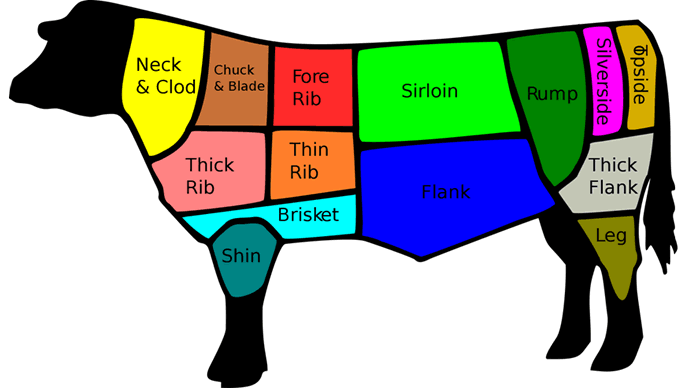



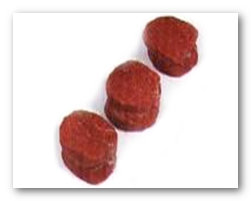

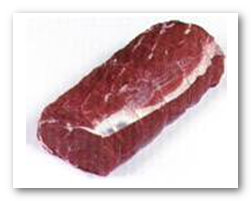


Beef and Veal
Beef is a good source of minerals, such as zinc, selenium, phosphorus and iron, and B vitamins. Red meat is the most significant dietary source of carnitine and, like any other meat (pork, fish, veal, lamb etc.), is a source of creatine.
Veal is the meat of young cattle (calves), as opposed to beef from older cattle. Though veal can be produced from a calf of both sex and any breed, most veal comes from young dairy-herd males.
Best for Roasting: Sirloin joint (not steaks), Rib joints, Flank and Fillet
Best for Slow Roasting: Top Side and Rump
Best for Braising and Pot Roasting: Flank, Brisket, Topside, Rump and Silverside.
Best for Boiling: Silverside and Brisket.
Best for Grilling and Frying: Fillet Steak, Sirloin Steak, Rump Steak, Porterhouse Steak and T-bone.
Best for Stewing: Flank, Chuck and Shin
Braising Steak
This steak is usually suitable for pie fillings, casseroles and stews.
Pot Roasting
Brisket is the best part for pot roast beef. It comes from the shoulder and rib area of the animal. It can be sold on the bone or boned, rolled and tied. Either way, brisket is best for slow cooking - either pot roasting or braising.
Stewing Steak
The best quality stewing steak comes from the chuck. It is not suitable for grilling or frying, but can be used in many casseroles and stews.
Steak
Fillet steak is one of the best cuts of beef. It comes from just below the ribs of the sirloin from the loin of the animal. A sign of whether a fillet steak is good for grilling is to look at the specks of fat running through the lean meat. The specks make sure that the steak doesn't dry out when grilling or frying.
Leg
The leg needs very long and very slow cooking. A leg of beef nearly always refers to the hind leg only. Great for casseroles and stews.
Rib of Beef
The forerib is a very large roasting joint that is either cooked on the bone or boned and rolled.
Prime Rib of Beef (or Wing)
This cut comes from between the fore ribs and sirloin in the loin area. It is a very expensive cut but is extremely good for roasting. A good creamy yellow fat layer will help keep the joint moist.
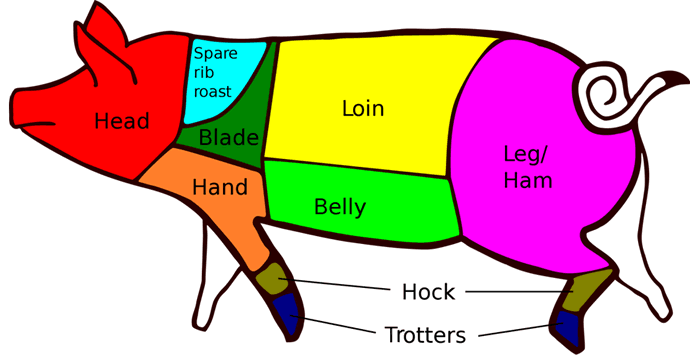
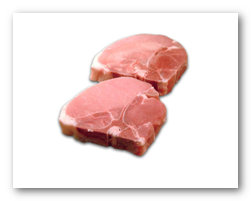
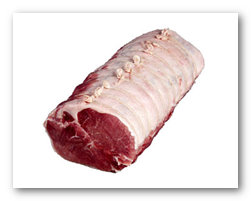


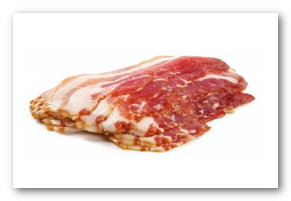


Pork and Bacon
Pork is the gastronomical name for meat from the domestic pig. The word pork denotes specifically the fresh meat of the pig that is left unsalted, but it is often mistakenly used as an all-inclusive term which includes cured, smoked, or processed meats (ham, bacon, prosciutto, etc). Pork is very high in thiamin (vitamin B1).
Spare Rib Roast/Spare Rib Joint/Blade Shoulder/Shoulder Butt
This is the shoulder and contains the shoulder blade. It can be boned out and rolled up as a roasting joint, or cured as "collar bacon". Not to be confused with the rack of spare ribs from the front belly. Pork butt, despite its name, is from the upper part of the shoulder. Boston Butt, or Boston-Style Shoulder, cut comes from this area, and may contain the shoulder blade.
Hand/Arm Shoulder/Arm Picnic
This can be cured on the bone to make a ham-like product, or used in sausages.
Loin
This can be cured to give back bacon or Canadian-style bacon. The loin and belly can be cured together to give a side of bacon. The loin can also be divided up into roasts (blade loin roasts, centre loin roasts, and sirloin roasts come from the front, centre, or rear of the loin), back ribs (also called baby back ribs, or riblets), pork cutlets, and pork chops. A pork loin crown roast is arranged into a circle, either boneless or with rib bones protruding upward as points in a crown. Pork tenderloin, removed from the loin, should be practically free of fat.
Fatback
The subcutaneous fat and skin on the back are used to make pork rinds, a variety of cured "meats", lardons, and lard.
Belly/Side/Side Pork
The belly, although a fattier meat, can be used for steaks or diced stir-fry meat. Belly pork may be rolled for roasting or cut for streaky bacon.
Legs/Hams
Although any cut of pork can be cured, technically speaking only the back leg is entitled to be called a ham. Legs and shoulders, when used fresh, are usually cut bone-in for roasting, or leg steaks can be cut from the bone. Three common cuts of the leg include the rump (upper portion), centre, and shank (lower portion).
Ham is a cut of meat from the thigh of the hind leg of pigs. Nearly all hams sold today are fully cooked or cured. Gammon steaks are thick cut and circular in shape. The word Gammon derives from the Old Northern French word jambe for hind-leg of the pig. The depth of meat to the bone is greatest at the top of the hind limb; cutting this piece from the side and curing it separately therefore cures the meat thoroughly, easily, and this cut is the original and to this extent authentic form of Gammon.
Trotters
Both the front and hind trotters can be cooked and eaten, as can the tail.
Spare Ribs
Spare ribs, or spareribs, are taken from the pig's ribs and the meat surrounding the bones. St. Louis-style spareribs have the sternum, cartilage, and skirt meat removed.
Duck
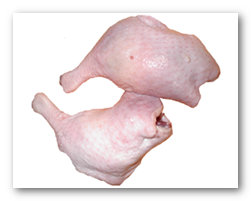

Properly cooked duck is both uniquely tasty and nutritious. It has been enjoyed by people the world over for centuries. Peking duck, for example, dates back to the time of the Yuan (Mongol) dynasty in China, when this breed was first developed and became known for its excellent gastronomic qualities.
De-boned duck breast can be grilled like steak, usually leaving the skin and fat on Internal organs such as heart and kidneys may also be eaten; the liver in particular is often used as a substitute for goose liver in foie gras.
Roast Peking duckling is a popular item on the menus of fine restaurants. Roast, braised or barbecued Peking duckling is also popular among home gourmets. More recently duck parts, such as breast and legs have become more available, which offer more options for diet conscious consumers.
Long Island roast duckling: This is a whole roasted bird, sometimes brined previously. When done properly, most of the fat melts off during the cooking process, leaving a crispy skin and well-done meat.

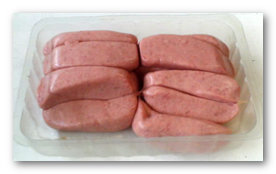

Sausages
A sausage is a food made from ground meat and often salt, herbs, and spices. The word sausage is derived from Old French saussiche, from the Latin word salsus, meaning salted. Cooked sausages are made with fresh meats, and then fully cooked. They are either eaten immediately after cooking or must be refrigerated.
British and Irish sausages are normally made from raw pork or beef mixed with a variety of herbs and spices. Many have recipes which are traditionally associated with particular regions (for example Cumberland sausages). They are traditionally cooked by frying, grilling or roasting prior to eating.
Due to their habit of often exploding due to shrinkage of the tight skin during cooking, they are commonly referred to as bangers, particularly when served with the most common accompaniment of mashed potatoes to form a bi-national dish known as bangers and mash.